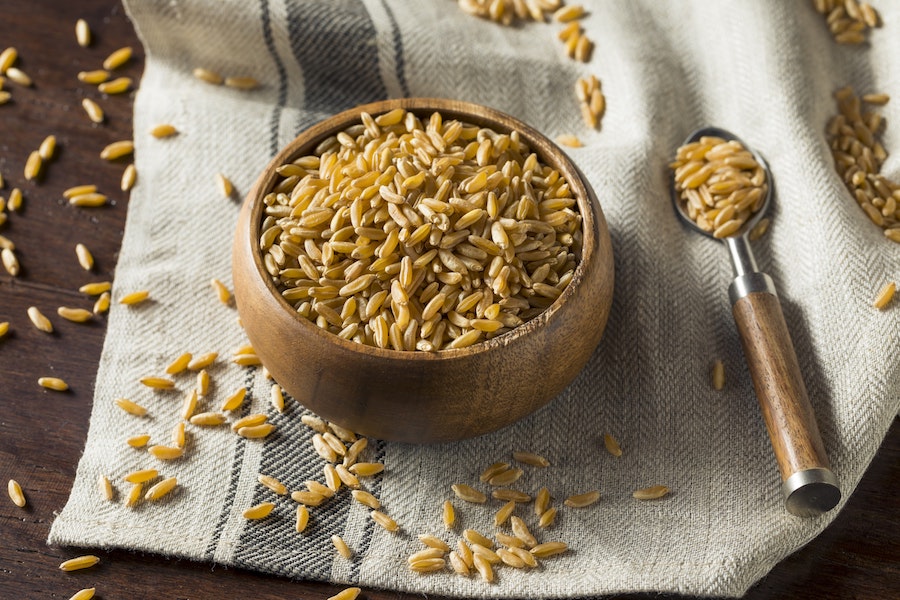Why kamut is set to be the next trendy super grain with healthy eaters
There’s been an unmistakable buzz around ancient grains over the past few years. From quinoa and teff to farro and bulgur, the foods that were once favoured by ancient civilisations have spiked in popularity with a generation of meat-free Instagrammers, thanks to their touted health benefits over processed wheat grains.
Now kamut (pronounced ka-moot) is set to big the next big earth-grown food we’ll be stirring into plant-based bowls and hashtagging on social media. Although it’s probably new to a lot of Western palettes, the millennia-old crop has been cultivated for centuries. Also known as ‘khorasan wheat’, it’s been dubbed the ‘Pharaoh grain’, owing to the fact that the seeds were rumoured to be discovered in ancient Egyptian tombs.
So what exactly does it contain for health buffs to love? For starters, it has 40% more protein than the common wheat that most of us eat, the essential nutrient which is important for building and repairing tissue. It also boasts more amino acids, vitamins, and minerals – including selenium, zinc, and inflammation-busting magnesium.
According to the Whole Grains Council (wholegrainscouncil.org), ancient grains are defined those that have gone largely unchanged over the past several hundred years. In contrast, most of the high-yield dwarf wheat we eat today has been developed by cross-breeding and crude genetic manipulation, meaning we don’t get the same nutritional benefits.
“Common wheat grains, or ’triticum aestivum’, is what you find in most breakfast cereals and flours; it accounts for 95% of all wheat produced globally,” explains Matt Miller, a nutritionist, personal trainer and founder of Broga (broga.uk.com). “Because it’s the largest commercial crop, it’s also the most manipulated. Every new season, agricultural companies that distribute grain to farmers will debut the latest version that’s been updated genetically to make it disease-resistant or have a higher yield.”
Miller says that ancient grains that are made from nature, like kamut, aren’t produced for specific commercial intent, meaning the production is still localised and the nutrients haven’t been stripped out. As well as being high in fibre and vitamins B and E, kamut also contains all eight essential amino acids, making it a complete protein.
It’s a particularly good food option for gym-goers; as well as having an impressive protein content (6g in every 100g), Harley Street nutritionist Rihannon Lambert (rhitrition.com) says it’s also known as a “high-energy grain”, because of its high percentage of lipids, which provide more energy than refined carbohydrates.
According to Miller, it’s pretty delicious stuff too. “It has a very particular taste profile. It’s golden in colour and has a very buttery flavour, so if you’re making bread – oh my God, is it amazing!”
Searching ‘kamut’ in Pinterest brings up all kinds of recipes; from vegan black bean kamut curry to kamut pilaf. To cook the grains, you simply need to soak them overnight and then simmer in a pan with water for around 45 minutes, until they’re soft enough to eat, and they can be stirred into salads and stews.
You can buy the grains from specialist health food shops and websites, like Healthy Supplies (£3.65 for 500g, healthysupplies.co.uk), but if stewing over a pan isn’t your forte, an easy switch to make is from plain flour to organic kamut bread flour (£2.85, waitrose.com). Miller’s favourite way to use it is in a homemade focaccia bread (just substitute it for normal flour) or added to American-style breakfast pancakes for a buttery protein kick.
Whether you’re already eating like ancient man or not, the grain train shows no sign of slowing down anytime soon. Get set to see plenty more ‘Pharaoh bowls’ and kamut curries on your social media feeds this year.
The Press Association
Latest posts by The Press Association (see all)
- 5 new books to read this week - November 23, 2024
- 3 easy Mary Berry recipes to make this season - November 22, 2024
- In Pictures: Party stalwart kept New Labour in touch with traditional supporters - November 21, 2024
- 6 easy indoor exercises to try this winter – and why they are good for you - November 19, 2024
- Martin Clunes: I can’t afford to retire – I’ve got too many horses - November 19, 2024





















